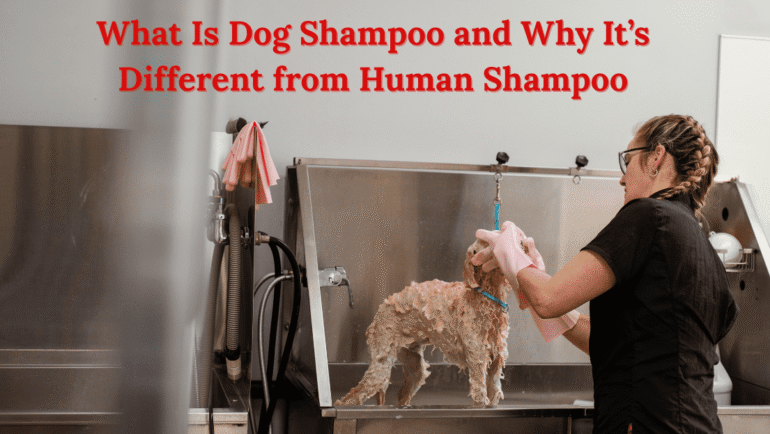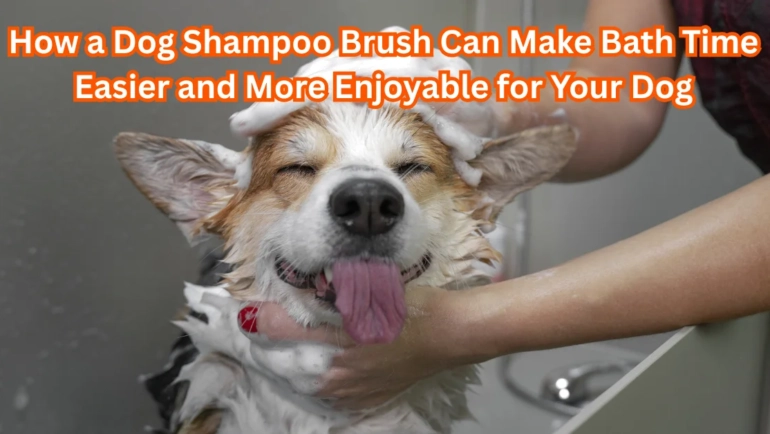39Views 0Comments
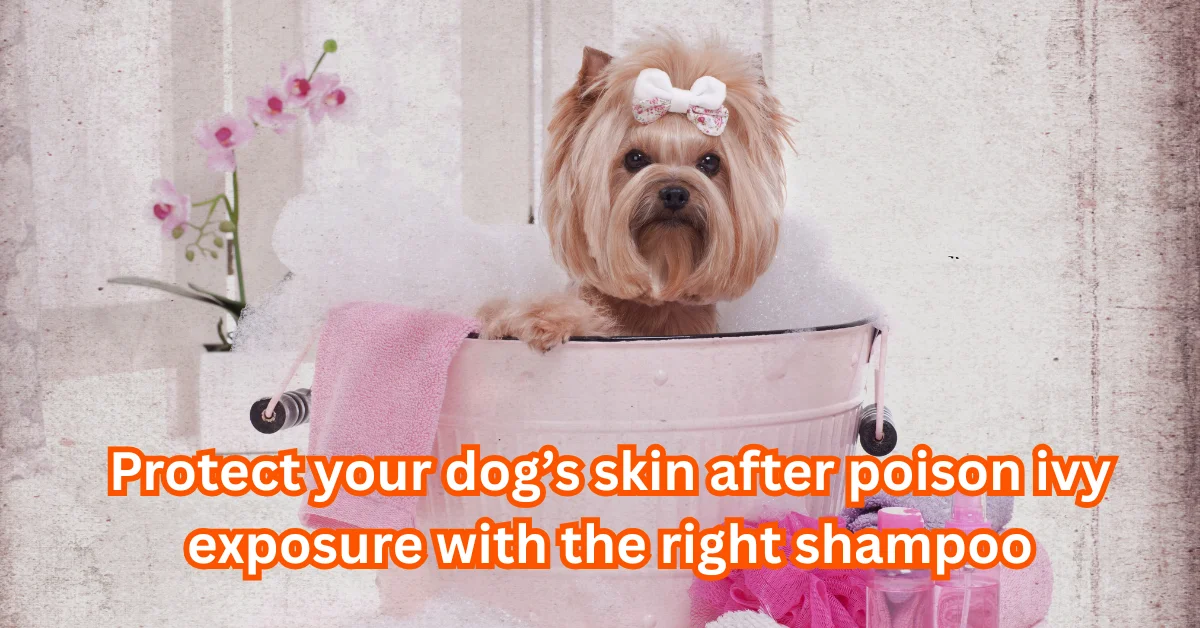
Poison Ivy Shampoo for Dogs: How to Protect and Heal Skin
Have you ever wondered whether or not that unusual rash on your dog is more than what you think it is? When your dog has itchy all over or runs home after taking a hike, covered in red spots on his belly, you can understand what we mean by helpless. I have done that, I have panicked, at 2 a.m. Googled, trying to distinguish between whether it is poison ivy, lice, or anything more problematic. The fact i, our dogs are not able to communicate with us about what ails them, but the skin does a good attempt. To find out what is affecting your dog, whether it is poison ivy or head lice and exactly what can be done with shampoos and treatments.
Keep reading this post. No hype, just the answers to make your best friend recover quickly.
What is Poison Ivy Shampoo for Dogs?
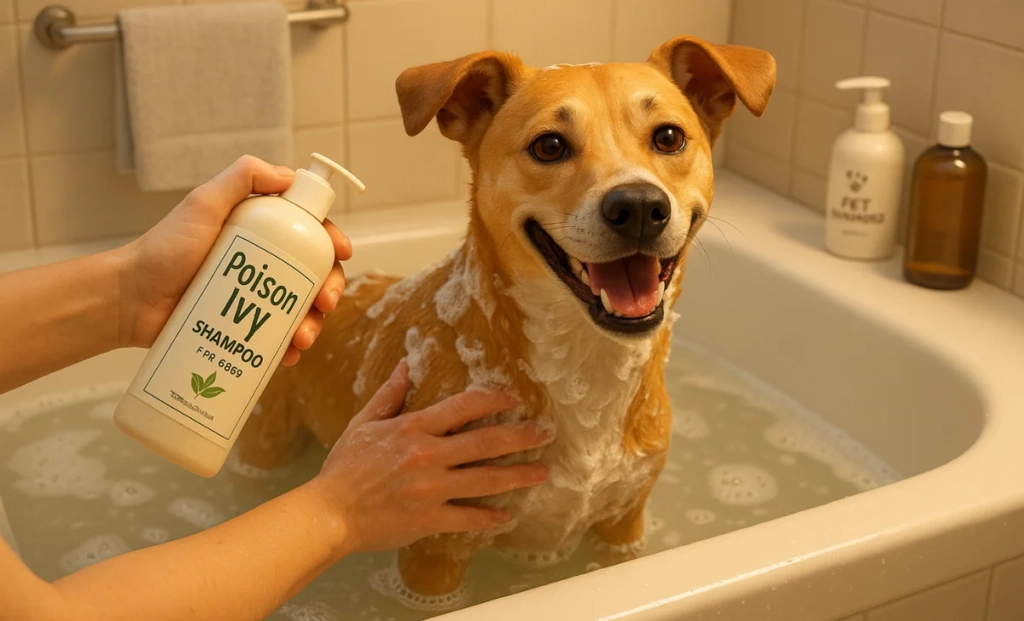
Poison Ivy Shampoo for Dogs is a gentle shampoo that you apply to the skin and coat of your dog to rinse off the Poison Ivy toxin (urushiol) once the toxin is in contact with your dog. It is this oil that makes the itch, reddening, swelling and discomfort. Dogs do not necessarily exhibit symptoms at once, but when they do, it is heart-stopping to observe.
I was on the hard way after learning when my curious retriever, Rumi, ran through a thicket of densely growing brush during a hike on a weekend. The next morning, she had angry red spots all over her body, and could be seen rubbing her face against the carpet as though she was asking somebody to shoot her. That was when I learned how useful a poison ivy shampoo can be, especially a gentle, quick one produced specifically to be used on dogs.
These shampoos are not common dog shampoos. Not only are they made to clean, but they are also made to neutralise the plant oils that cause the reaction in the first place. A dog who has been in the woods or any place where poison ivy is found can only get the irritation stopped before it begins, or at least less uncomfortable by giving your pup a rub down with this shampoo as soon as you suspect it of having been in the poison ivy.
Key Ingredients and Benefits of Poison Ivy Shampoo for Dogs
Aloe Vera: Herb of Heavenly Approach to the Skin
One such default ingredient in such shampoos is aloe vera. It has cooling properties, decreases inflammation and accelerates the healing of the skin. Rumi had had that itchy rash and applied the aloe formula, and it brought her immediate relief- her tail started wagging again before the bath was over!
Oatmeal: soothing, moisturising oatmeal reliefs
Colloidal oatmeal contains moisture-binding properties and moisturises inflamed skin. It is particularly useful in dogs that may have very sensitive skin or dry skin since these kinds would not respond well to sterner cleaners.
Chamomile: Anti-Stress and Anti-Inflammatory
Chamomile is not only related to tea. It reduces the redness or irritation in shampoo and makes your dog calm down, especially when you bathe them, as dogs might not be particularly fond of it.
Clearers: Eliminating the Cause of the Problem
These shampoos also have non-destructive dog-friendly cleaners that aid in cutting off the urushiol oil from the skin and fur. This is the key thing- until you get the oil away, it may still go on reacting or perhaps go on spreading to you and other animals in the house.
How Do I Treat My Dog for Poison Ivy?
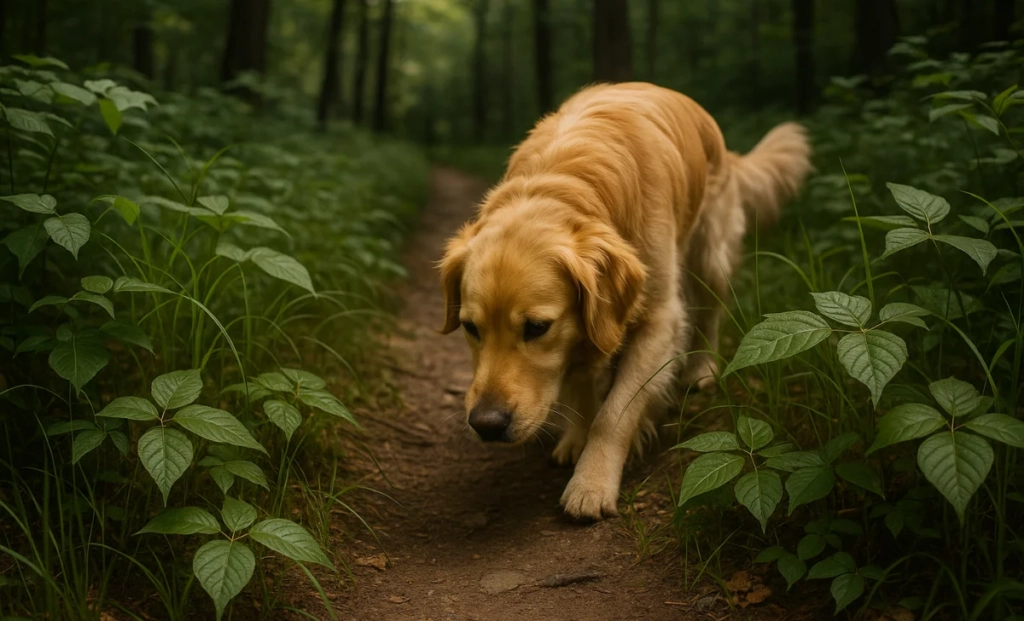
When your dog has poison ivy, it is important to react immediately: clean the affected body part with a poison ivy dog-safe shampoo, do not rub and leave the oleaginous residues on the skin, and relieve the skin with veterinary-recommended medications.
Reactions to poison ivy portray a very unpleasant experience to the dogs, and close care dispels most reactions at home.
I can still recall the same day, when Rumi came back home after walking the familiar trail in top spirits as always, yet by night, she could not stop scratching. Her stomach was red, and obviously, she was upset. This is when it occurred to me that she must have rubbed on poison ivy. This is how I assisted her to recover, and how you can do it as well.
Step 1: Get your Dog out of the Object
Even before you know that your dog has been exposed to poison ivy, take it inside the house. Oils in the plant can remain on their fur and continue irritating them or even pass to humans or fellow pets.
Step 2: Poison Ivy Dog Shampoo.
Bathe your dog with a Poison Ivy Shampoo for Dogs, which will have to be done with a gentle yet thorough scrubbing. These shampoos will dissolve and wash away urushiol, the oil that leads to the reaction.
When Rumi experienced her breakout, I did rub her up twice just to be sure, particularly in the belly area and legs, that is where she was most red. Make sure that you rinse very thoroughly and that you do not use your normal shampoo on your dog, as it is not made to remove all the oil.
Step 3: Safeguard Yourself and Other People
The poison ivy oil is devious in that it can hang on fur and is easily transferred. When possible, always wear gloves and wash your hands, clothing and anything your dog came into contact with during the episode. I even took a bit of time and cleaned Rumi can leash and bed a little to ensure no bugs on there.
Step 4: Calm the Skin
You can apply a topical treatment such as hydrocortisone cream that vets recommend if your dog remains itchy or swollen after the bath. However, it is always a good idea to perform a check-up with your vet before utilising them over-the-counter, as there are substances safe in humans, but dangerous to dogs.
Step 5: Monitor His or her Recovery
The majority of dogs feel much better when they have a good bath; still, some of them might manifest more severe reactions. Take note of such symptoms as excessive swelling, sores that are oozing or changes in behaviour. Just in case something does not seem right, do not be afraid to call your vet.
Is There a Dog Shampoo for Head Lice?
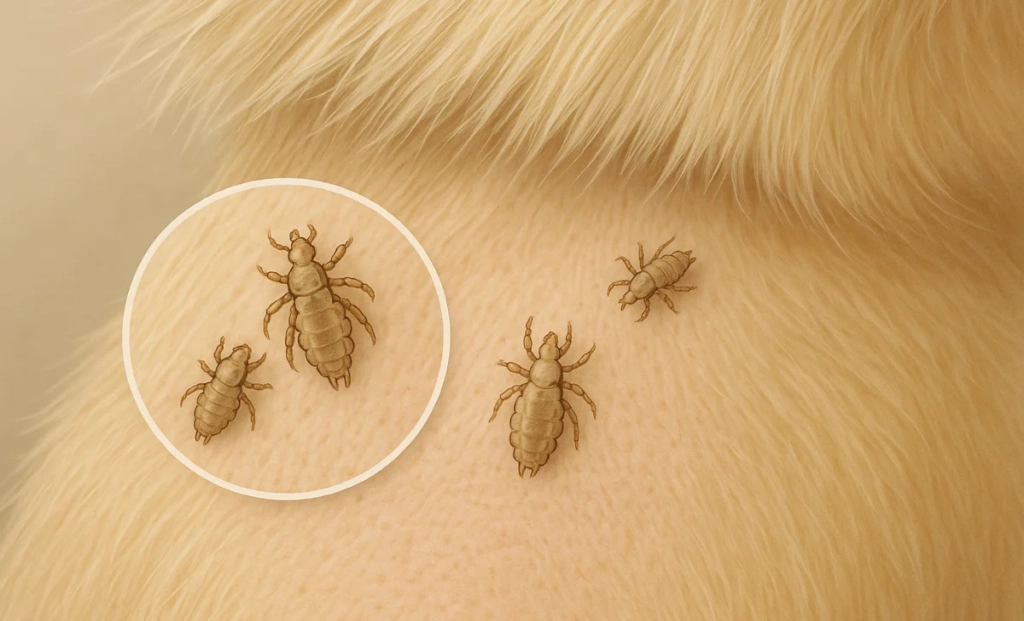
There are indeed shampoos formulated to eradicate the presence of head lice among dogs. Such shampoos contain some ingredients that help to kill lice, and others that provide skin relief. As opposed to ordinary dog shampoos, lice shampoos not only kill the parasites but also keep the dog safe from a relapse. It is essential to use the appropriate product to make your dog lice-free as well as comfortable.
Dogs can also get head lice, though it is quite rare, and is often found in a home with multiple pets, or when one is in close contact with animals that have head lice. These shampoos are able to destroy adult lice as well as the eggs (nits), and this breaks the cycle of lice and reduces the chances of a lice attack at a later date.
Active Ingredients in Dog Shampoo for Lice
Pyrethrin
Pyrethrin is an insecticide that is botanical in origin and that is derived from and isolated from the plant chrysanthemum flowers. It is common in pet products as a lice repellent shampoo since it only has enough pesticidal effects on lice, but it is moderate on a dog’s skin. It destroys the nervous system of the lice and the lice become paralysed and eventually die.
Permethrin
Permethrin is a more powerful version of pyrethrin and of synthetic nature. It can be effective against different external parasites such as lice, fleas, and ticks. Nevertheless, however, it is worth mentioning that permethrin can never be applied to cats as they are poisoned by it.
Neem Oil
Neem oil is a natural product possessing anti-parasitic and antibacterial effects. It has the effect of repelling and killing lice and soothing aggravated or itchy skin as well. Dog owners who seek a less harsh but more natural shampoo are likely to employ neem shampoos.
Recommended Lice Shampoos for Dogs
Vet Best flea and tick advanced strength shampoo
Vet’s Best Natural Flea and Tick Shampoo for Dogs – Plant-Based Formula with Certified Essential…
- DOG AND PUPPY SHAMPOO : Say goodbye to pesky fleas and ticks in your dog’s hair and fur;…
- CERTIFIED NATURAL FLEA AND TICK PREVENTION FOR DOGS : Made with certified natural…
- VETERINARIAN FORMULATED: Our dog flea & tick shampoo provides your pet with the best care;…
This is a plant-based shampoo applied to the fleas and ticks, although it proves efficient on the lice too. Its mixture of essential oils provides a solution in treating infestations in a natural manner, leaving the coat squeaky clean and fresh.
Hartz UltraGuard Pro Flea and Tick Shampoo
Sale
Hartz Nature’s Shield Flea & Tick Dog Shampoo Maximized Botanical Protection & Prevention with…
- CONTAINS: one – 14oz bottle of Hartz Nature’s Shield Flea & Tick Dog Shampoo
- EFFECTIVE WITH NATURAL OILS: Flea & Tick Dog Shampoo that effectively kills fleas, ticks,…
- PLANT-BASED INGREDIENTS: Maximized botanical flea & tick protection with effective…
This shampoo has the advantage of relieving lice, fleas and ticks using permethrin, which is formulated to give a quick and effective reprieve. Its use to treat dogs is recommended over the age of 12 weeks and it is normally prevalent during severe infestations.
Sentry Pesticide-Free Flea and Tick Shampoo
Sale
SENTRY Oatmeal Flea and Tick Shampoo for Dogs, Rid Your Dog of Fleas, Ticks, and Other Pests, Hawaii…
- IDEAL FOR DOGS: This rich, conditioning formula with oatmeal kills pests that can harm…
- CLEANS AND CONTROLS: SENTRY oatmeal shampoo cleans, deodorizes and conditions your dog’s…
- RID YOUR DOG OF FLEAS: SENTRY Flea and Tick Oatmeal Shampoo for dogs and puppies has a…
The indicated option in the treatment of the lice is also based on natural elements of neem oil, so it can be considered to be useful to dogs with delicate skin or to those owners who do not want to use chemical-based ones.
How Often Can I Use Poison Ivy Shampoo for Dogs?
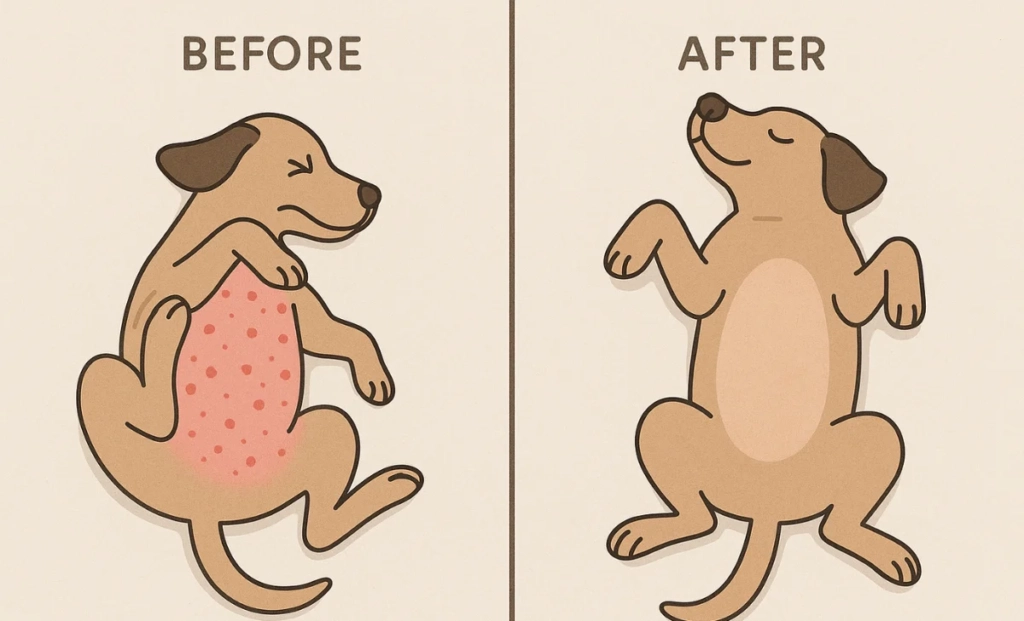
The poison ivy shampoo used on a dog can address the problem, but only as an occasional application to your dog that is usually used directly after exposure or in the case of an active skin reaction.
These shampoos work well in the elimination of the offending oils of poison ivy; nevertheless, their application on a regular basis can leave your dog without the natural skin protection. The majority of them are developed as special care products, not products to be used on a regular basis as grooming solutions.
The idea is to rinse out the urushiol oil, or poison in poison ivy, as fast as possible after being exposed to it. After the oil is washed out and the symptoms are starting to subside, then the tendency is not to need to repeat the bath unless the irritation continues.
Postexposure First Use
The sooner you think that your dog has touched poison ivy, the quicker you should apply the shampoo. A good bath will also release much of the oils deposited on their coat, and the likelihood of a complete skin reaction will be less.
Reiteration of Treatment
In case of minimal scratching or redness, you can reapply the shampoo in 2 to 3 days. But you should not overwash your dog with this type of shampoo because it may further dry out your dog or make him even more sensitive. Check the product label all the time to observe its usage instructions.
In what circumstances should to call your Veterinarian
In case of worsening symptoms or their absence after a second wash, call your veterinarian. Constant annoyance can mean some medicated treatment or prescription relief is needed. Your vet would also help to determine whether the shampoo that your dog is using can still be used, depending on the condition of your dog’s skin.
How Can I Safely Remove Head Lice from My Dog?
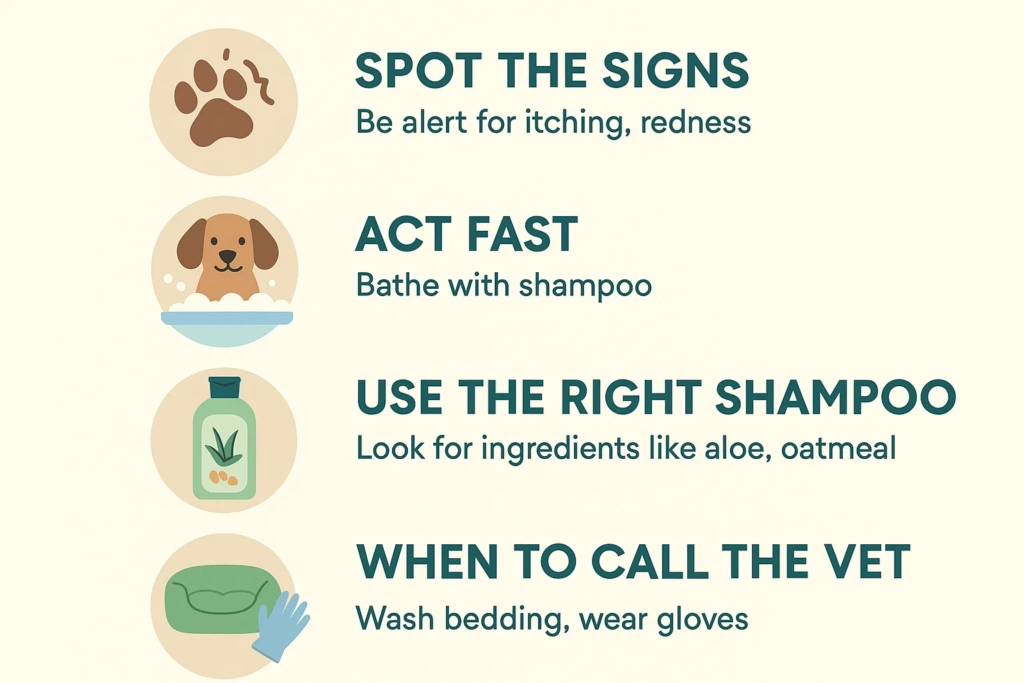
There are several steps involved in eradicating head lice on your dog successfully without harm to your pet. You must first exterminate the parasites, physically eliminate them and clean the environment of your dog to deter the chances of reinfection.
You can begin by washing your dog using a shampoo with active ingredients such as pyrethrin or permethrin, and meant to treat lice. These are good chemicals to kill lice and also kill lice eggs, thus preventing the outbreak at its origin. Once the bath is done, try to brush out the fur using a fine-toothed comb and be careful to brush out your dog, especially at the neck, ear and head where the lice prefer to hide. It is to check that no lice or nits can be removed by hand.
When your dog has been taken care of, the next step should be cleaning their surroundings. Cleaning: Dispose of bedding, blankets, toys, and grooming equipment in hot water and dry in a hot oven to kill any remaining lice or eggs. Clean the vacuum places where your dog sleeps or plays, so as to get rid of chances of reinfestation. Inasmuch as the lice are species-specific and will not be transferred to humans easily, by ensuring that everything is clean, the cycle can be averted.
You should also visit your vet in case the infestation is still there after treatment or your dog experiences increasing skin irritation. They can suggest having a prescription-strength product, or will also look into other skin conditions that may be contributing to the problem.
Last thoughts: The Correct Shampoo to Use
Skin health is not a minor grooming concern for your dog, but an aspect of his or her well-being and happiness. It could be poison ivy and head lice, but when you know how to select the proper shampoo, you are already a step ahead on the way to providing your pup with the comfort he/she require. You now have the equipment to act fast, treat carefully and assist your dog to heal.
As it is, nothing is more painful than having your best friend in pain and not knowing how to help him/her. Now, however, you do. Next time you encounter the problem on their skin, calm yourself, take the right shampoo and relax because you can do this.
Common Questions About Treating Dog Skin Irritations
1. Can poison ivy spread from my dog to other pets or humans?
Yes, poison ivy oil (urushiol) can linger on your dog’s fur and transfer to other animals or people through direct contact. Your dog won’t spread a rash like a contagious illness, but the oil itself can cause new reactions if not removed quickly.
2. Are poison ivy and head lice common in indoor dogs?
Not usually. Dogs who mostly stay indoors are at much lower risk. However, even brief outdoor exposure during walks, visits to parks, or yard time can lead to contact with poison ivy or lice from other animals or contaminated surfaces.
3. Can I use human lice shampoo or poison ivy wash on my dog?
No, human shampoos are not formulated for a dog’s skin pH and may contain ingredients that are toxic or irritating to pets. Always use products specifically made for dogs, and consult your vet before applying anything unfamiliar.
4. How long does it take for poison ivy symptoms to go away in dogs?
Most mild cases improve within 3–7 days after proper treatment. If symptoms persist or worsen beyond a week, it’s best to consult your vet, as your dog may have a secondary infection or need prescription-strength relief.
5. Is it possible for my dog to get lice again after treatment?
Yes, reinfestation can happen if the environment isn’t thoroughly cleaned. Wash bedding, toys, collars, and grooming tools. Also, check other pets in the household, as lice can spread through close contact.
6. Are there natural remedies for poison ivy on dogs?
Some natural options like aloe vera, oatmeal, and chamomile may soothe mild irritation, but they don’t remove urushiol oil. Always pair natural remedies with a proper shampoo designed to cleanse the skin after exposure.
7. Can puppies use poison ivy or lice shampoo safely?
Some shampoos are not recommended for puppies under 12 weeks due to their sensitive skin. Always check the product label and consult your vet before using any medicated or pest-targeting shampoo on young dogs.
8. What does a lice infestation look like on a dog?
Lice are tiny, white or yellowish insects often seen around the ears, neck, and shoulders. You may also notice your dog scratching more than usual, along with dry, flaky skin or matted fur in infested areas.
9. Do lice on dogs bite humans?
No, dog lice are species-specific and cannot survive on human hosts. While they may crawl onto people, they can’t feed or reproduce on human skin, so they are not considered a risk to human health.
10. Can I prevent poison ivy reactions in the future?
Yes, avoid high-risk areas during walks, especially wooded trails or overgrown grass. You can also use protective sprays on your dog’s coat or wipe them down with a damp cloth after outdoor play to remove potential irritants.





